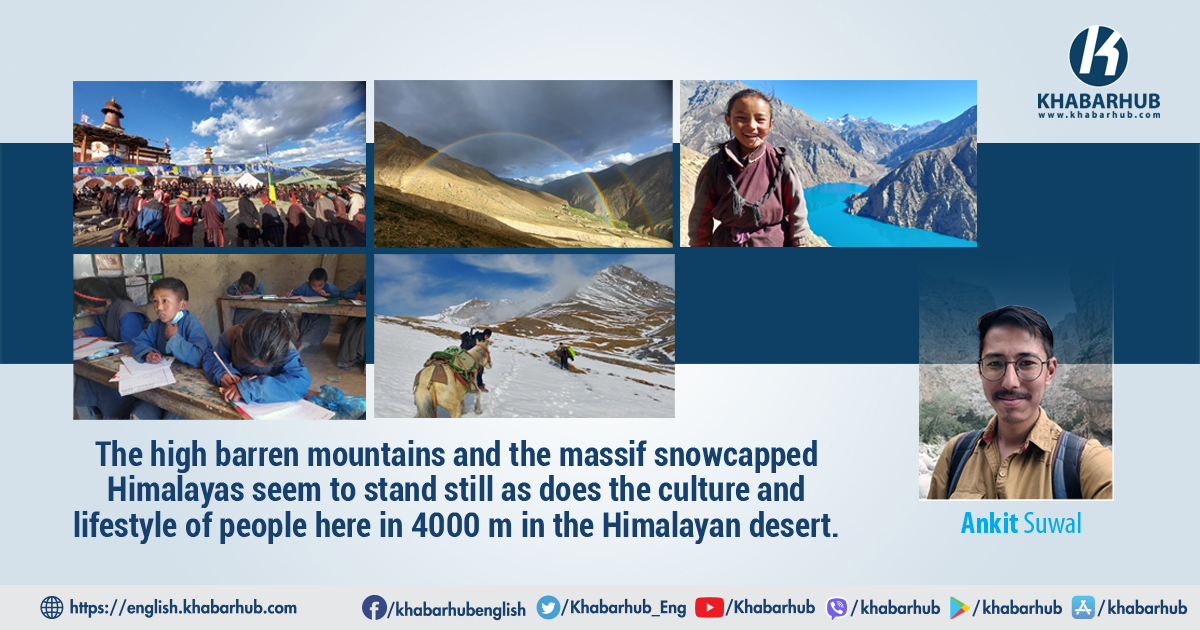The philosophy of Buddhism states that the existence of reality is in a constant, inevitable change.
Yet the high barren mountains and the massif snowcapped Himalayas seem to stand still as does the culture and lifestyle of people here in 4000 m in the Himalayan desert.
It feels like entering an ancient civilization where time has stood still for centuries.
Yet my journey in Upper Dolpa had been flowing like the Mugu Karnali that has shaped these mighty rocks for time unknown.
Just like the geography and climate, life here is harsh and tough. However, people here are as warm, pleasant, innocent and welcoming.
With no electricity, roads, or modern infrastructure, life here is extremely basic. There are no shops or financial institutions, and barter and communal support are still practiced.
Seasonal transhumance and high-altitude crop cultivation sustain the community, while yaks, mountain horses, and donkeys transport goods and people.
I was captivated by the mythological tale of how the lake was formed: a powerful Dakini, in her rage, brought down mountains upon the people of Ringmo who had betrayed her while she was pursued by Padmasambhava, an incarnation of Buddha.
We reached Upper Dolpa, the land of the Snow Leopard, after two flights from Kathmandu to Nepalgunj and then Jufal, followed by 7 days of trekking and horse riding over a 5100-meter pass in the Himalayas.
The Voyage to Upper Dolpa
The team was ready to depart from Kathmandu, but delays with the Himalayan Development Initiative caused nearly a month of waiting before we signed contracts and received our air tickets.
On Day 1, during the COVID-19 crisis, we flew from Kathmandu to Nepalgunj, spent the night there, then took a smooth 6 am flight to Jufal on a small twin otter plane. We were greeted by snow-covered Himalayas and stayed in Dunai, an hour’s drive from Jufal.
On Day 2, we were stranded in Dunai for a week due to heavy snow but explored Lower Dolpa during our stay.
The stunning scenery impressed us, especially on hikes and a road trip to Tripura Sundari. On Day 9, we trekked for 8 hours to Lasicap, where we stayed in tents. By Day 12, we reached Dho-Tarap Valley and saw Upper Dolpa, the filming location of the movie Caravan.
On day 13, we departed from Dho-Tarap on horseback to traverse the formidable Jang-La Pass, standing at 5,100 meters above sea level.
The ride was both steep and awe-inspiring. At times, we wished we had trekked instead of riding due to the challenging ascent.
After four hours of climbing and maneuvering the horses through deep snow, reaching the top of Jang-La Pass was a breathtaking experience.
The dark blue sky, sparkling snow-covered peaks, glaciers, and the cluster of Dhaulagiri summits to the east brought warm tears to my frostbitten cheeks.
After an adrenaline-charged horse ride, stunning landscapes, singing and dancing, and approximately 15 hours of walking, we finally arrived at Rappa village around 6 p.m. We were utterly exhausted.
Along the way, we traversed barren yellow mountains, steep descents, ancient monasteries, and villages like Namdo, Saldang, and Tiling.
We marveled at the clear, deep blue Mugu Karnali, where stones were visible even in the depths. After quenching our thirst and that of the horses from this stunning river, we ascended to Nyisal Gaon in the late afternoon.
For the first time, the northern Himalayas appeared on our southern side. We had crossed the wild terrains and arrived in Upper Dolpa.
On day 15, we arrived at Nyisal village, our destination at 4,000 meters above sea level.
The next morning, we explored the village, fields, and school. Nyisal, the northernmost village in Dolpa, features cuboid yellow mud houses, vibrant chortens, a few horses in each household, the ancient Yangjer monastery, and the Himalayas to the south, creating a Shangri-La experience.
We arrived in Nyisal at the start of summer, as life began to recover from a harsh, snow-filled winter. The region’s vegetation consisted mainly of thorny Caragana and honeysuckle, which were bare and brown.
Over time, these plants turned green, bloomed, and produced small red berries called “Serokh.” During the berry season, local kids eagerly gathered around the plants.
In the first weeks before school started, the fields were dry and empty, and my teammates and I fell ill one after another. We weren’t sure if it was COVID-19 or the 4,000-meter altitude.
With no basic medical services and running out of paracetamol, we turned to local Amgee’s herbs. One herb helped my voice but didn’t relieve the fever, body aches, or coughs that kept me awake for over a week.
We had to adapt to the lack of toilets and running water. The mountain slopes served as natural toilets, and the school’s crooked, half-broken toilet was the only one in the village.
We joked that the builder must have been drunk due to its slanted design. After Pema Tsering got the door fixed, it was somewhat functional.
Eventually, Pema, Nyima Tashi (a friendly teacher), and some villagers repaired the water supply, and after two days of hauling pipes, we finally had water at the school!
Shree Yanjeer Gumba Basic School was established on paper in 1975 but was only physically built in 2011, after four political regimes had passed. In Nyisal Gaon, the only state-run institutions are the school and a police station, with police presence limited to half the year.
The school lacks government teachers and relies on villagers and volunteers. Its infrastructure is poor, with a single, dilapidated toilet and inadequate classroom, office space, and facilities.
Classes were held outdoors, where the beautiful view was often overshadowed by the challenges of windy and rainy days. Despite these hardships, villagers with a strong sense of ownership helped build a playground.
The children, despite the poor conditions, developed a deep attachment to their classroom, fiercely guarding it from other grades, which sometimes led to conflicts.
Their pride in their space deeply moved us, making us wonder how much more they would thrive with better, child-friendly classrooms like those in Kathmandu.
Academically, the children exceeded our expectations. With smaller class sizes, we could focus on individual development.
I worked on improving their handwriting, reading, writing, and understanding of English and Nepali, using National Geographic and science videos for additional knowledge. I also taught them chess and Microsoft Word. While they could read and write English fluently, they struggled with understanding it.
We maintained an active eco-club, with leaders elected democratically among the students. After school, we held eco-classes discussing topics like climate change, the water cycle, and environmental preservation.
The children engaged in activities like drawing the water cycle, discussing climate change, and delivering speeches on community and environmental issues. We organized weekly clean-up activities and received donations from WWF, including reading materials, dustbins, and soaps.
In addition to school activities, our team and local teachers collected data for Aarati’s thesis, which involved visiting every household in the village. We were warmly welcomed with butter tea, chyang, aarak, and dinner, which helped us better understand the community.
Outside of school and community work, we visited villages such as Musi Gaon, Saldang, and Karang, and explored various pastures, sometimes on horseback. Summer weekends included refreshing swims in the river.
Death of Pema Dorje
We never expected our journey to be marred by tragedy. Eight-year-old Pema Dorje, an orphan living at Ghephel Gumba, often asked innocent yet profound questions like, “If a helicopter can fly to Dolpa, why not a plane or rocket?” or “Are the sun, stars, and moon living things?”
His curious mind, despite his difficult circumstances, was always engaged. Dorje, one of the brightest students, frequently helped older classmates with their homework and was always smiling.
On a hike to Markgom Monastery, Dorje guided us energetically, effortlessly bounding up steep slopes. That was the last time I saw him so full of life. He had mentioned a lump in his throat that made eating difficult, and soon after, he fell ill.
I initially thought it was a curable iodine deficiency, but in Upper Dolpo, one of the world’s most isolated and impoverished regions, access to medical care was nearly impossible. Though local Amjees and lamas prayed for him, hope was scarce.
We never imagined that an iodine deficiency could be so fatal.
In our final days, we celebrated Dashain with a tika ceremony at the school, introducing the festival to the Buddhist children and villagers in a heartwarming cultural exchange. As our project concluded, we were warmly invited to meals and celebrations, enjoying their hospitality and delicious food.
In Nyisal, where modern medicine was scarcely trusted and herbal or religious treatments were the norm, our attempts to seek medical help for Dorje—despite pledges to call a nurse or take him to the health post in Karang Gaon—were ineffective.
After two weeks of suffering from severe malnutrition, Dorje tragically lost his life.
Losing Pema Dorje was the most poignant moment among many highs and lows of the fellowship. One of our major challenges was raising awareness about education and health in the community.
Despite numerous programs, speeches, and one-on-one counseling, making a meaningful impact proved difficult and sometimes frustrating.
However, after much effort, we organized a health camp at the school, inviting a nurse from Karang village for thorough check-ups. Nearly half the village attended, and seeing our efforts yield tangible results was gratifying.
We also made several household visits, encouraging parents to send their children to Kathmandu for further education with support from the Himalayan Development Initiative.
Only five children went to Kathmandu; the rest were sent to a Buddhist monastery. Despite our efforts, it was disheartening to see the full potential of these children go unrealized.
In our final days, we celebrated Dashain with a tika ceremony at the school, introducing the festival to the Buddhist children and villagers in a heartwarming cultural exchange. As our project concluded, we were warmly invited to meals and celebrations, enjoying their hospitality and delicious food.
Planning our return involved logistical arrangements. After a brief SMC meeting, it was decided that the children’s parents, along with their horses, would guide us to Kangla High Pass, with the remainder of the journey to Kathmandu up to us.
Following a few cloudy and snowy days, the weather cleared on our departure morning. The entire village came to bid us farewell, with hugs, tears, and photo sessions.
We aimed to reach Shey Gumba the same day. After nine hours of horseback riding through Karang, Saldang, and two 5,000-meter passes, we arrived in Shey Gumba at 11 p.m., under the cover of darkness.
The journey was filled with singing, dancing, and the hope for better education. It was inspiring to be part of the dreams of parents sending their children to Kathmandu for opportunities they never had.
At dawn the next day, we set out for Kang La Pass at 3 a.m., aiming to reach Phoksundo before sunset. Along the way, parents covered their children with blankets and walked beside them on the treacherous path. Due to the freezing cold, I opted to walk rather than ride.
At 5,400 meters on the mighty Kang-La Pass, we were surrounded by snow-capped peaks, a crescent moon in the deep blue sky, and dazzling sunlight glittering off the snow. Amid this stunning landscape, the children bid farewell to their parents.
Upon landing in Kathmandu at night, the children were awestruck. Tsring Lhamo, one of our students, exclaimed with wide eyes, “Kathmandu looks like the night sky filled with bright, colorful stars.” After an extraordinary journey, we finally returned home.
While most were tearful, Phurba Lhamo, one of our students, smiled with excitement for her future. Her father, Sonam Wangdi, with tearful eyes, asked us to care for his daughter and guide her well. Other fathers, too, entrusted us with their daughters’ education, knowing their next reunion might be years away.
We followed the trail along the foothills of Mt. Kanjiroba, experiencing the transition from frozen streams to rivers and massive waterfalls.
The changing vegetation from tundra and alpine to coniferous forests, combined with hours of solitude, was a deeply soulful experience.
The students’ awe at seeing trees and chickens for the first time added a touch of innocent humor to our adventure.
The next day, we hiked along the trail to Phoksundo, heading towards Ringmo village. The deep blue of Phoksundo Lake beneath the towering snow-capped mountains was mesmerizing.
I was captivated by the mythological tale of how the lake was formed: a powerful Dakini, in her rage, brought down mountains upon the people of Ringmo who had betrayed her while she was pursued by Padmasambhava, an incarnation of Buddha.
According to legend, her curse made the lake lifeless, though scientifically, Phoksundo is an oligotrophic lake with too few nutrients for life to thrive.
The serenity of this experience was brief. Upon reaching the viewpoint of the lake, we encountered modern city dwellers in flashy clothing, a stark contrast to our remote surroundings. It was a mixed feeling of relief and disorientation as we arrived in Phoksundo.
Early the next morning, we rushed to Jufal to catch our flight amid a hectic schedule. We traveled to Suligadh and then took a jeep to Jufal.
Thus, as expressed by Hermann Hesse, “The bird is struggling out of the egg. The egg is the world. Whoever wants to be born must first destroy a world. The bird is flying to God. The name of the God is called Abraxas.”
Along the steep trails above the Phoksundo River, we were deeply shaken by the tragic news of a young girl who had fallen from a cliff. Her team, including her brother and friends, was devastated.
We later learned the fall was fatal and rescue teams were on their way. This event became a topic of discussion among trekkers. In the evening, we reached Suligadh, where the children saw a jeep for the first time.
The next morning, we were disappointed to find all flights fully booked due to a surge in local tourists. We decided to rest and explore Jufal. We enjoyed local apples, beans, and stories, and eventually secured a flight home in time for Tihar, the Hindu festival of lights.
Upon landing in Kathmandu at night, the children were awestruck. Tsring Lhamo, one of our students, exclaimed with wide eyes, “Kathmandu looks like the night sky filled with bright, colorful stars.” After an extraordinary journey, we finally returned home.
While I had hoped to bring about external change, the journey transformed me instead. Experiencing Dolpa’s culture, people, and landscape fostered a profound sense of humility within me. It was through grappling with both external challenges and internal reflections that I uncovered this newfound humility.
Thus, as expressed by Hermann Hesse, “The bird is struggling out of the egg. The egg is the world. Whoever wants to be born must first destroy a world. The bird is flying to God. The name of the God is called Abraxas.”









Comment